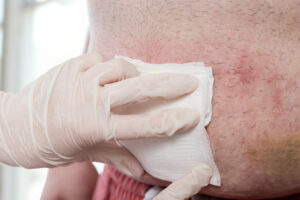In our last installment, we discussed Biofilm in Chronic Wounds and Sharp Debridement. Previously, we also discussed how and why Chronic Wounds develop due to the lack of regulatory control of ROS or Reactive Oxygen Species (H2O2, OH, etc). Today, I would like to share my recent experiences and personal observations especially as it relates to Sharp Debridement.
Over the last several weeks, I have had the privilege in re-visiting several wound clinics and witnessing first-hand the progression of several different types of wounds over the course of 3-4 weeks. My last recent visit was no exception: what I had noticed was an improvement not only in the size of the wounds, but also the appearance and health of the wound. Granted, there were a few exceptions with the development of new wounds and pre-existing wounds that were minimally progressing, the overall presentation was improvement. Was it because of new topical therapies, methodologies, or dressings the institution adopted in between visits? Or was it because of more frequent visits at the clinic and more home health care intervention? The answer was actually very simple: adequate sharp debridement and wound bed preparation. In essence, every clinic I had visited had minor differences in the use of topicals, wound dressings, and methodology which was driven not only by budgetary constraints, but also by ambulatory vs non-ambulatory presentations. However, the most common feature I had observed was that with consistent and proper sharp debridement performed on a weekly basis with intermittent adjunct topical therapy applications, the better the outcomes! Some institutions had the luxury of skin substitutes while others did not. Other clinics had a plethora of topical wound agents and modalities for advanced wound care while others had specialized in house capabilities. But the overall comparative difference in improvement and healing did not seem to be what was placed on the wound, but more so on how the wound was sharply debrided.
But even though sharp debridement was being performed in several facilities I had visited, there were many barriers in which this methodology was performed. This was not only based on the acumen of the clinician, but also what the provider felt most comfortable using (again observations made by the author). Some clinicians preferred a curette while others used scissors and pickups: still others preferred a scalpel. The technique of sharp debridement also varied as I noticed clinicians that were more aggressive than others: some felt comfortable with just removing superficial skin slough with pinpoint bleeding while others would sharply debride down to the vascular bed of the wound. Some clinicians concentrated more efforts on the edges of the wounds, while others focused more centrally. There were also barriers that I noticed which influenced the clinician’s approach consisting of pain and anti-coagulation therapy thereby resulting in more caution and conservative, limited debridement.
Interestingly, my observations also included why the clinician used a certain type of instrument while others did not. Several of the clinicians used solely curettes while others did not and one of the main reasons for the latter was due to excessive bleeding. Some clinicians preferred just Iris scissors and a pickup since they were concerned with pain issues while others used a combination of all. Again, this came back to what the clinician felt comfortable using, what was available for use, and what was available due to the facilities budget. All in all, what seemed to be positively consistent about before and after wound presentations was directly correlated with how adequate the wound bed was sharply debrided. In essence, outcomes of improvement were aligned with how well the wound bed was prepared thus resulting in how adequate the sharp debridement was executed. This was also consistent with etiological factors being addressed with appropriate antibiosis, vascular integrity, infection control, laboratory analysis, radiology, and off-loading measures.
From my many observations over the years, my many journeys to wound care facilities, and based off of my own experience in limb salvage: is there a more consistent means of delivering adequate, safe and consistent sharp debridement? With the use of surgical instrumentation available since the advent of the Bard Parker handle and #15 blade, has there been any changes in which sharp debridement has evolved from the old traditions? Is there an instrument that can assist with those patients who are anti-coagulated and or have pain? Bottom line up front: is there an instrument that can adequately irradicate Biofilm, provide precise and effective sharp debridement, and decrease the amount of pain that is commonly associated with traditional surgical instrumentation?
The answer may actually surprise you in my next installment! Please check back often and until next time, fair winds and following seas.
Cheers,
Dr. F. Derk


